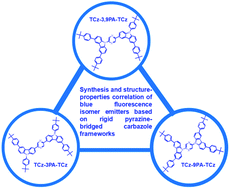Synthesis and structure–property correlation of blue fluorescence isomer emitters based on rigid pyrazine-bridged carbazole frameworks†
Abstract
Three novel blue fluorescence isomer emitters, namely 2,5-bis(6,9-bis(4-(tert-butyl)phenyl)-9H-carbazol-3-yl)pyrazine (TCz-3PA-TCz), 9-(5-(6,9-bis(4-(tert-butyl)phenyl)-9H-carbazol-3-yl)pyrazin-2-yl)-3,6-bis(4-(tert-butyl)phenyl)-9H-carbazole (TCz-3,9PA-TCz) and 2,5-bis(3,6-bis(4-(tert-butyl)phenyl)-9H-carbazol-9-yl)pyrazine (TCz-9PA-TCz), with a donor–acceptor–donor structure were synthesized and characterized. TCz-3,9PA-TCz in the thin solid powder state showed much higher thermal stability than TCz-3PA-TCz and TCz-9PA-TCz. The maximum photoluminescent emission wavelengths of TCz-3PA-TCz, TCz-3,9PA-TCz and TCz-9PA-TCz in toluene solution were 423, 435 and 454 nm, which were aggregation-induced quenching active. The absolute photoluminescent quantum yields of doped films for TCz-3PA-TCz, TCz-3,9PA-TCz and TCz-9PA-TCz were 10.75%, 4.46% and 16.70%, which were considerably improved relative to those of the pure film. The driving voltage, maximum external quantum efficiency, current efficiency, power efficiency and luminance of doped OLEDs based on TCz-9PA-TCz fabricated by spin coating were 4.0 V, 2.67%, 4.12 cd A−1, 2.46 lm w−1 and 8052 cd m−2. Furthermore, the doped OLEDs with TCz-3,9PA-TCz as a dopant fabricated by thermal deposition in vacuum showed a driving voltage of 3.5 V, maximum luminance of 6369.67 cd m2 and maximum external quantum efficiency of 3.85% at a brightness of 100 cd m−2. The linking model analogous to TCz-3,9PA-TCz was validated to be a more feasible way to combine pyrazine with carbazole moieties to produce highly efficient and stable electroluminescent blue light materials.



 Please wait while we load your content...
Please wait while we load your content...